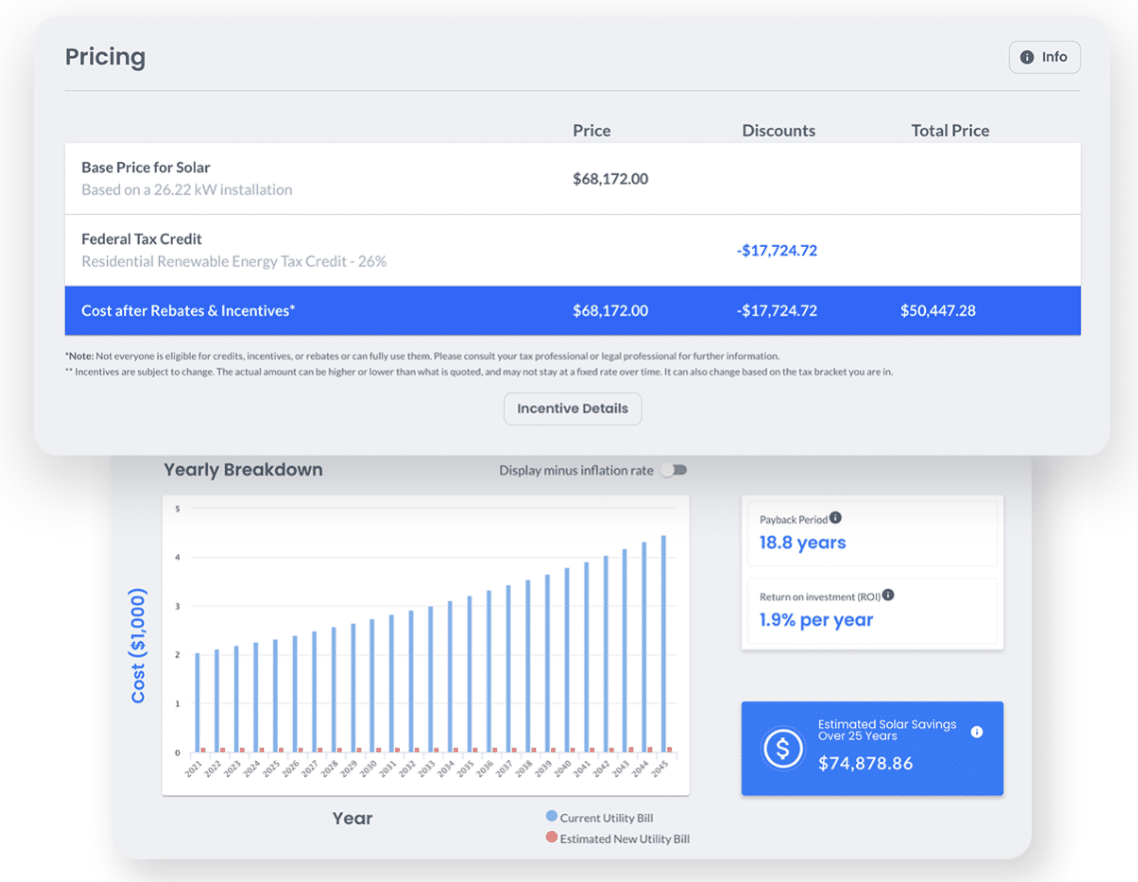
Today’s home and business owners are knowledgeable, conscientious investors in renewable energy and solar power options. Most individuals will spend extensive time researching alternative energy sources before contacting a solar installer.
Due to the ease of research on the internet, the solar market is a buyer’s market. Most interested clients will contact more than one solar installer to find the best option, which means that your proposal needs to provide all the information required to make the sale, but it should also stand out against the competition.
Generally, solar installers will receive a list of potential clients interested in purchasing solar panels. It’s essential to create an enticing solar proposal for the client to make the sale. Offering a detailed solar proposal is an effective tool for the final sale to the prospective client.
Things to Include in a Solar Proposal
The smallest professional details may be the biggest selling point in a solar proposal. Each proposal should include the basics, including the solar installer’s name, company, and contact details. This basic information provides a level of professionalism as well as a means for the homeowner to get in touch with you or your company if they need help or have any follow-up questions.
The same applies to the prospective client’s details. By writing out all the contact details, the solar installer creates a one-of-a-kind solar proposal for the client. The proposal will need specific aspects to draw the client’s attention to the contract along with the basics.
1. Remember Word Usage
Use easy-to-understand wording when filling out the solar proposal for the potential client. If a client does not understand the wording, the competition may win the client’s contract. Minimize technical jargon and the use of hard-to-understand words.
Understanding a solar proposal is necessary for client commitment. Remember, your potential clients aren’t experts in the solar industry like you are and can easily get confused when faced with too much technical information about their solar project. Don’t intimidate them with a complicated proposal.
2. The Free Quote
These days, with the amount of competition in the solar industry, charging a fee for a quote is a huge faux-pas for any solar company. A free quote offer should always be on the table, whether the potential client makes it clear that they want your business or if they are just testing the water and looking around with less intention to buy.
Use the promise of a free quote as a lead magnet to gather homeowner information and include them in your sales funnel and marketing strategy. Even if they don’t decide to buy today, you’ll have their information for later attempts at making the sale.
3. The Return on Investment
Beginning with a summary of the savings of installing solar panels reminds the client that installation will provide a return on investment (ROI).
- Explain the value of the solar panel installation on a monthly budget.
- Explain the projected amount of money the solar system could save the client. Emphasize how the system will eventually pay for itself.
A portion of the summary should provide details on the savings, credit, or cash allowances for producing too much energy in a given time frame. The utility company may pay the client.
Explain how the renewable energy source is environmentally friendly. Everyone wants to do their part for the environment. Writing out an extra sentence about the environmental aspects of solar panels may provide an additional selling point.
The ROI should be laid out in an easy-to-understand way, in a logical order on the proposal. Ideally, ROI information should be right next to the quoted price of the system. Consider using graphs and other visuals to show off the value of going solar, rather than simply using text to try to make your point.
4. Provide Work Details
Provide a summary of the solar panel installation process. Solar installers will be intruding on the client’s personal property for a given amount of time. A client wants reassurance the installation process is effective and efficient. A client who understands all the process details is more likely to accept the proposal.
Describe the details of the work, the noise level, and the number of service personnel on the property during the installation process.
- The type of equipment that will be brought onto the client’s property.
- The projected timeline for the installation process.
- Warranty details of the workmanship and manufacturer.
- Provide a summary of the approval and inspection processes.
- An overview of the permit, zoning, or local ordinance process.
- Include a change order agreement.
You can also consider including a section on the proposal listing all the project steps with approximate completion dates to keep the client in the loop about what will happen with their solar project after they sign on the dotted line.
This could include dates of inspections, when you expect to have their permit completed, which dates you will be on-site to install the system, and when the installation will be completed. If your proposal is hosted on the web, include check boxes next to these items so that the homeowner can easily view their project status whenever they like.
5. Licensing
Reassure the client that the installation experts are professionals who will respect and preserve the property during the entire process.
- Provide licensing details of the solar installers, contractors, or builders.
- Provide references or testimonials of prior work completion.
- Provide photos of past completed solar installations.
A solar installer’s job is to build trust with the prospective client. By providing references from past consumers, photos, and licensing details, the solar installer assures the homeowner that the process is credible and reliable.
6. The Finances
Ask the client about the method of payment or financing options being considered for the solar installation process. The upfront initial investment may require additional financing. Displaying the information on a graph or table will allow the client to choose financing options. Forms of payment options may include leases, PPAs, bank or other lending institutions loans, or cash from savings.
Depending on the upfront costs or initial investment costs, the solar proposal should include a payback timeline for the client to view.
At this point, you should provide details of available rebates or cash allowances. Along with company incentives, discuss the current government tax credits and available incentives. The tax credits should include both national and state incentives with some details about why they qualify for such credits.
7. Beyond the Basic Information
Clients want to know the investment will last beyond the installation process. Even though solar panels are highly durable with minimal maintenance, issues may arise. Provide the client with peace of mind by reassuring future issues will be promptly handled.
- Provide clients with details on basic cleaning and maintenance.
- Give contact details for service representatives.
In Closing
Your clients work hard for their money. Solar panels are a major investment with a high rate of return. By explaining the details in the solar proposal in a simple and easy-to-understand way, solar installers can build enough trust with potential clients to make the sale.
After all, all anyone wants is to make what they feel is the best choice for themselves and their home while also saving money with a quality product.



 United States
United States Germany/Austria
Germany/Austria Brazil
Brazil Netherlands
Netherlands Japan
Japan